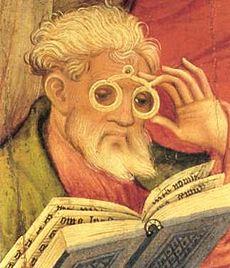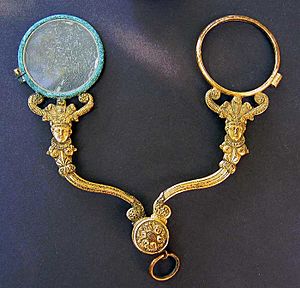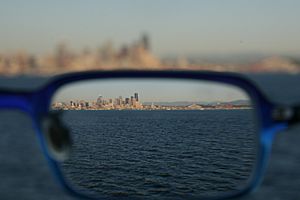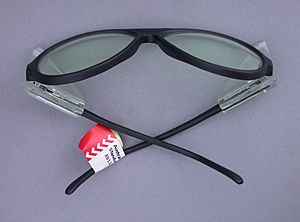Eyeglasses facts for kids

Eyeglasses (U.S), or spectacles (Brit.) are pieces of glass or clear plastic, called lenses, in a frame that holds them in front of someone's eyes.
Corrective lenses let some people see or read better if they have problems seeing. This is used by person who have poor eyesight. Contact lenses also help people see better.
Sunglasses are a kind of eyeglasses that keep too much sunlight from getting in people's eyes.
Some eyeglasses block blue light from a computer, game, smart phone and TV.
Eyeglasses have many models. So it may be worn for fashion.
Contents
History
Precursors


The use of a convex lens to form an enlarged/magnified image is discussed in Alhazen's Book of Optics (1021). Its translation into Latin from Arabic in the 12th century was instrumental to the invention of eyeglasses in 13th century Italy. Englishman Robert Grosseteste's treatise De iride ("On the Rainbow"), written between 1220 and 1235, mentions using optics to "read the smallest letters at incredible distances". A few years later in 1262, Roger Bacon is also known to have written on the magnifying properties of lenses.
Sunglasses, in the form of flat panes of smoky quartz, were used in China during the 12th century. Similarly, the Inuit have used snow goggles for eye protection. While they did not offer any corrective benefits they did improve visual acuity via the pinhole effect.
Invention
The first eyeglasses were made in Italy in about 1286, but it is not clear who the inventor was. In a sermon delivered on February 23, 1306, the Dominican friar Giordano da Pisa (ca. 1255–1311) wrote "It is not yet twenty years since there was found the art of making eyeglasses, which make for good vision... And it is so short a time that this new art, never before extant, was discovered. ... I saw the one who first discovered and practiced it, and I talked to him." Giordano's colleague Friar Alessandro della Spina of Pisa (d. 1313) was soon making eyeglasses. The Ancient Chronicle of the Dominican Monastery of St. Catherine in Pisa records: "Eyeglasses, having first been made by someone else, who was unwilling to share them, he [Spina] made them and shared them with everyone with a cheerful and willing heart." By 1301, there were guild regulations in Venice governing the sale of eyeglasses.

The earliest pictorial evidence for the use of eyeglasses is Tommaso da Modena's 1352 portrait of the cardinal Hugh de Provence reading in a scriptorium. Another early example would be a depiction of eyeglasses found north of the Alps in an altarpiece of the church of Bad Wildungen, Germany, in 1403. These early glasses had convex lenses that could correct both hyperopia (farsightedness), and the presbyopia that commonly develops as a symptom of aging. It was not until 1604 that Johannes Kepler published the first correct explanation as to why convex and concave lenses could correct presbyopia and myopia.
Early frames for glasses consisted of two magnifying glasses riveted together by the handles so that they could grip the nose. These are referred to as "rivet spectacles". The earliest surviving examples were found under the floorboards at Kloster Wienhausen, a convent near Celle in Germany; they have been dated to circa 1400.
Types
Glasses come in many styles. They can be marked or found by their primary function, but also appear in combinations such as prescription sunglasses or safety glasses with enhanced magnification.
Corrective
Corrective lenses are used to correct refractive errors by bending the light entering the eye in order to alleviate the effects of conditions such as nearsightedness (myopia), farsightedness (Hypermetropia) or astigmatism. The ability of one's eyes to accommodate their focus to near and distant focus alters over time. Also, few people have eyes that show exactly equal refractive characteristics; one may need a "stronger", (i.e. more refracting), lens than the other. A common condition in people over forty years old is presbyopia, which is caused by the eye's crystalline lens losing elasticity, progressively reducing the ability of the lens to accommodate (i.e. to focus on objects close to the eye). Corrective lenses, to bring the image back into focus on the retina, are made to conform to the prescription of an ophthalmologist or optometrist. A lensmeter can be used to verify the specifications of an existing pair of glasses. Corrective eyeglasses can significantly improve the life quality of the wearer. Not only do they enhance the wearer's visual experience, but can also reduce problems that result from eye strain, such as headaches or squinting.
Pinhole glasses are a type of corrective glasses that do not use a lens. Pinhole glasses do not actually refract the light or change focal length. Instead, they create a diffraction limited system, which has an increased depth of field, similar to using a small aperture in photography. This form of correction has many limitations that prevent it from gaining popularity in everyday use. Pinhole glasses can be made in a DIY fashion by making small holes in a piece of card which is then held in front of the eyes with a strap or cardboard arms.
The most common type of corrective lens is "single vision", which has a uniform refractive index. For people with presbyopia and hyperopia, bifocal and trifocal glasses provide two or three different refractive indices, respectively, and progressive lenses have a continuous gradient. Reading glasses provide a separate set of glasses for focusing on close-by objects. Reading glasses are available without prescription from drugstores, and offer a cheap, practical solution, though these have two simple lenses of equal power, so will not correct refraction problems like astigmatism or refractive or prismatic variations between the left and right eye. For total correction of the individual's sight, glasses complying to a recent ophthalmic prescription are required. Adjustable-focus eyeglasses might be used to replace bifocals or trifocals, or might be used to produce cheaper single-vision glasses (since they don't have to be custom-manufactured for every person).
Safety
Safety glasses are worn to protect the eyes in different situations. They are made with break-proof plastic lenses to protect the eye from flying debris or other matter. Construction workers, factory workers, machinists and lab technicians are often required to wear safety glasses to shield the eyes from flying debris or hazardous splatters such as blood or chemicals. As of 2017, dentists and surgeons in Canada and other countries are required to wear safety glasses to protect against infection from patients' blood or other body fluids. There are also safety glasses for welding, which are styled like wraparound sunglasses, but with much darker lenses, for use in welding where a full sized welding helmet is inconvenient or uncomfortable. These are often called "flash goggles", because they provide protection from welding flash. Nylon frames are usually used for protection eyewear for sports because of their lightweight and flexible properties. Unlike most regular glasses, safety glasses often include protection beside the eyes as well as in front of the eyes.
Sunglasses

Sunglasses provide improved comfort and protection against bright light and often against ultraviolet (UV) light. Photochromic lenses, which are photosensitive, darken when struck by UV light. The dark tint of the lenses in a pair of sunglasses blocks the transmission of light through the lens.
Light polarization is an added feature that can be applied to sunglass lenses. Polarization filters are positioned to remove horizontally polarized rays of light, which eliminates glare from horizontal surfaces (allowing wearers to see into water when reflected light would otherwise overwhelm the scene). Polarized sunglasses may present some difficulties for pilots since reflections from water and other structures often used to gauge altitude may be removed. Liquid crystal displays often emit polarized light making them sometimes difficult to view with polarized sunglasses. Sunglasses may be worn just for aesthetic purposes, or simply to hide the eyes. Examples of sunglasses that were popular for these reasons include teashades and mirrorshades. Many blind people wear nearly opaque glasses to hide their eyes for cosmetic reasons.
Sunglasses may also have corrective lenses, which requires a prescription. Clip-on sunglasses or sunglass clips can be attached to another pair of glasses. Some wrap-around sunglasses are large enough to be worn over top of another pair of glasses. Otherwise, many people opt to wear contact lenses to correct their vision so that standard sunglasses can be used.
3D glasses
The illusion of three dimensions on a two dimensional surface can be created by providing each eye with different visual information. 3D glasses create the illusion of three dimensions by filtering a signal containing information for both eyes. The signal, often light reflected off a movie screen or emitted from an electronic display, is filtered so that each eye receives a slightly different image. The filters only work for the type of signal they were designed for.
Anaglyph 3D glasses have a different colored filter for each eye, typically red and blue or red and green. A polarized 3D system on the other hand uses polarized filters. Polarized 3D glasses allow for color 3D, while the red-blue lenses produce an image with distorted coloration. An active shutter 3D system uses electronic shutters. Head-mounted displays can filter the signal electronically and then transmit light directly into the viewers eyes.
Anaglyph and polarized glasses are distributed to audiences at 3D movies. Polarized and active shutter glasses are used with many home theaters. Head-mounted displays are used by a single person, but the input signal can be shared between multiple units.
Magnification (bioptics)
Glasses can also provide magnification that is useful for people with vision impairments or specific occupational demands. An example would be bioptics or bioptic telescopes which have small telescopes mounted on, in, or behind their regular lenses. Newer designs use smaller lightweight telescopes, which can be embedded into the corrective glass and improve aesthetic appearance (mini telescopic spectacles). They may take the form of self-contained glasses that resemble goggles or binoculars, or may be attached to existing glasses.
Yellow-tinted computer/gaming glasses
Yellow tinted glasses are a type of glasses with a minor yellow tint. They perform minor color correction, on top of reducing headaches due to lack of blinking. They may also be considered minor corrective unprescribed glasses. Depending on the company, these computer or gaming glasses can also filter out high energy blue and ultra-violet light from LCD screens, fluorescent lighting, and other sources of light. This allows for reduced eye-strain. These glasses can be ordered as standard or prescription lenses that fit into standard optical frames. Due to the ultra-violet light blocking nature of these lenses, they also help users sleep at night along with reducing age-related macular degeneration.
Anti-glare protection glasses
Anti-glare protection glasses, or anti-reflective glasses, can reduce the reflection of light that enters our eyes. The lenses are given an anti-glare coating to prevent reflections of light under different lighting conditions. By reducing the amount of glare on your eyes, vision can be improved. The anti-glare also applies to the outer glass, thus allowing for better eye contact.
Related pages
Images for kids
-
Detail of a portrait of the Dominican Cardinal and renowned biblical scholar Hugh of Saint-Cher, painted by Tommaso da Modena in 1352
-
Portrait of Cardinal Fernando Niño de Guevara by El Greco circa 1600 shows glasses with temples passing over and beyond the ears
-
A portrait of Francisco de Quevedo y Villegas, 1580–1645
-
Harry S. Truman, 33rd President of the United States, had poor vision.
-
Former United States senator Barry Goldwater in horn-rimmed glasses
See also
 In Spanish: Gafas para niños
In Spanish: Gafas para niños

















